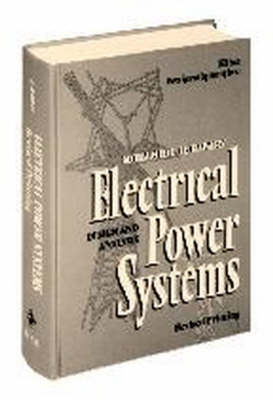
Electrical Power Systems
Wiley-IEEE Press (Verlag)
978-0-7803-1140-4 (ISBN)
- Titel erscheint in neuer Auflage
- Artikel merken
Key features include more than 500 illustrations and diagrams,clearly developed procedures and application examples, importantmathematical details, coverage of both alternating and directcurrent, an additional set of solved problems at the end of eachchapter, and an historical overview of the development of electricpower systems. This book will be useful to both power engineeringstudents and professional power engineers.
Mohamed El-Aref El-Hawary, is an Egyptian-born Canadian scientist of electric power system studies and the involvement of traditional/modern optimization algorithms, fuzzy systems, and artificial neural networks in their applications.
Preface.
Chapter I Introduction.
1.1 The Development of Electric Power Systems.
1.2 Outline of the Text.
Chapter II Some Basic Principles.
2.1 Introduction.
2.2 Power Concepts.
2.3 Three Phase Systems.
2.4 Power System Representation.
Chapter III Power Generation and the SynchronousMachine.
3.1 Introduction.
3.2 The Synchronous Machine: Preliminaries.
3.3 Fields in a Synchronous Machine.
3.4 A Simple Equivalent Circuit.
3.5 Open-Circuit and Short-Circuit Characteristics.
3.6 Principal Steady-State Characteristics.
3.7 Power-Angle Characteristics and the Infinite BusConcept.
3.8 Static Stability Limit Curves.
3.9 Accounting for Saliency.
3.10 Salient-Pole Machine Power Angle Characteristics.
Chapter IV The Transmission Subsystem.
4.1 Introduction.
4.2 Electric Transmission Line Parameters.
4.3 Line Inductance.
4.4 Line Capacitance.
4.5 Two-Port Networks.
4.6 Transmission Line Models.
Chapter V The Load Subsystem.
5.1 Introduction.
5.2 General Theory of Transformer Operation.
5.3 Transformer Connections.
5.4 Three-Phase Induction Motors.
Chapter VI Analysis of Interconnected Systems.
6.1 Introduction.
6.2 Reduction of Interconnected Systems.
6.3 The Per Unit System.
6.4 Network Nodal Admittance Formulation.
6.5 The General Form of the Load-Flow Equations.
6.6 The Load-Flow Problem.
6.7 Getting Started.
6.8 Newton-Raphson Method.
6.9 The Newton-Raphson Method for Load-Flow Solution.
Chapter VII High-Voltage Direct-Current Transmission.
7.1 Introduction.
7.2 Main Applications of HVDC.
7.3 HVDC Converters.
7.4 Classifications of Direct-Current Links.
7.5 Some Advantages of HVDC Transmission.
7.6 Some Economic Considerations.
7.7 Converter Circuits: Configurations and Properties.
7.8 Analysis of the Three-Phase Bridge Converter.
7.9 Inversion in Three-Phase Bridge Converter.
7.10 HVDC Link and Converter Control Characteristics.
7.11 Analysis of HVDC Link Performance.
Chapter VIII Faults on Electric Energy Systems.
8.1 Introduction.
8.2 Transients During a Balanced Fault.
8.3 The Method of Symmetrical Components.
8.4 Sequence Networks.
8.5 Line-to-Ground Fault.
8.6 Double Line-to-Ground Fault.
8.7 Line-to-Line Fault.
8.8 The Balanced Three-Phase Fault.
Chapter IX System Protection.
9.1 Introduction.
9.2 Productive Relays.
9.3 The X-R Diagram.
9.4 Relay Comparators.
9.5 Generator Protection.
9.6 Transformer Protection.
9.7 Bus Bar Protection.
9.8 Transmission Line Overcurrent Protection.
9.9 Pilot-Wire Feeder Protection.
9.10 Distance Protection.
9.11 Power Line Carrier Protection.
9.12 Computer Relaying.
Chapter X Power System Stability.
10.1 Introduction.
10.2 The Swing Equation.
10.3 Electric Power Relations.
10.4 Concepts in Transient Stability.
10.5 A Method for Stability Assessment.
10.6 Improving System Stability.
Chapter XI Optimal Operation of Electric PowerSystems.
11.1 Introduction.
11.2 Modeling of Fuel Costs for Thermal Generation.
11.3 Optimal Operation of an All-Thermal System: EqualIncremental Cost Loading.
11.4 Accounting for Transmission Losses.
11.5 Optimal Operation of an All-Thermal System, IncludingLosses.
11.6 Optimal Operation of Hydrothermal Systems.
Some Solved Problems.
Problems.
Index.
| Erscheint lt. Verlag | 9.3.1995 |
|---|---|
| Reihe/Serie | IEEE Press Series on Power and Energy Systems |
| Sprache | englisch |
| Maße | 181 x 240 mm |
| Gewicht | 1395 g |
| Themenwelt | Technik ► Elektrotechnik / Energietechnik |
| ISBN-10 | 0-7803-1140-X / 078031140X |
| ISBN-13 | 978-0-7803-1140-4 / 9780780311404 |
| Zustand | Neuware |
| Haben Sie eine Frage zum Produkt? |
aus dem Bereich



